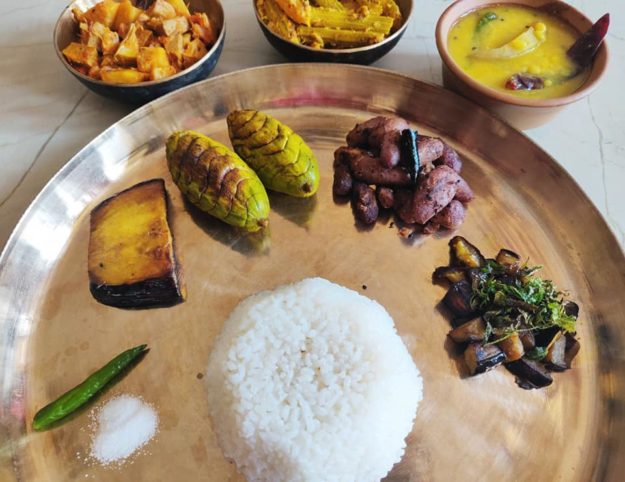Chaitra Sankranti


A day that almost sneaks past in the shadows of Naba Barsha is Chaitra Sankranti, the last day of the Bengali calendar and infinitely more interesting in symbolism than today’s gluttony-infected celebrations of Naba Barsha.
Since childhood, Chaitra Sankranti was personal and comforting. It is the last day of Chaitra, the last month of Bangla calendar, and is the last day of bosonto (Spring). After which, we enter into a new year, into a new season – summer.
The day had a unique food ritual on my mother’s side of the family that has roots in Dhaka; one
that all of us used to look forward to year long.
In the morning of Chaitra Sankranti, summer fruits such as water melon, water chestnuts, cucumbers, dates – those which give respite in the hot and humid Bengal summers – were offered to the house deities. The children were then given the fruits as prasad with a breakfast of flattened rice, curd and jaggery. Chhatu or roasted gram flour sherbet with cold milk and bananas, and bael pana was also served. Any sweet sherbat, like mishri water is served on this day.
This diet has mythological and Ayurvedic significance. The day is rooted in the Mahabharata. Bhishma Pitamah was lying on his bed of arrows in the battlefield and was thirsty. Arjuna, on hearing this shot one of his arrows deep into the earth, and from the furrow spurt out sweet, cool water that sprang into Bhishma’s mouth. Satiated, Bhishma said that anyone who would give cool, sweet water to other on this day will be absolved of all sins. On a more worldly note, a cooling, and hydrating diet is given to both Gods and mortals to signify the required change in food habits to prepare the body for the heat.
Coming back to food at home, lunch was served late, so that the food would keep us going through the night. It was the last meal of the day and lunch was what we all cousins would wait for.
It was a sattvik vegetarian affair, which even the meat-loving Bengali kids didn’t complained about. Such was its charm!
Even the dreaded neem-begun bhaja that the meal started with had takers that day. My grandmother would pluck the almost-red young neem leaves from the tree to be fried crisp and mixed with fried, cubed eggplant and a dash of salt and ghee.
This was followed by roasted moong dal cooked with roundels of tender bitter gourds, tempered with panchphoron in ghee, accompanied by mashed potatoes with pungent mustard oil. Next came motor dal (split peas) cooked with unripe, green mangoes from that one tree which had fragrant, ‘kacha-meethe’ (sweet when unripe) fruits. This was accompanied by potol bhaja (fried pointed gourds) and sesame fritters. The potol had be to mid-sized, scraped not peeled and scales scored on its body to let the seasoning seep in.
Next came a personal favourite – sojne data’r chorchori (stir fried drumsticks with pumpkin, potatoes and other vegetables cooked in mustard paste). Each vegetable would be cut into equal sized batons, cooked tender but not mushy. The pumpkin had to be red, the drumstick mature enough to be fleshy but with tender skin. The mustard was ground on mortar. The final item on the menu was the pièce de résistance. Unripe jackfruit curry made with ghee and freshly ground spices that separated the great cooks from the good ones.
There was a story that the meal told. It signified the most sound lesson and philosophy of life. It was meant to make everyone experience all the tastes of life – bitter, sweet, sour, pungent, spicy – an ode to a year well spent. An acceptance and acknowledgement of everything that life sent our way during the year. Respecting the need and place for all kinds of experiences in shaping a well-rounded life.
The kitchen was then shut after that one meal and would only reopen on Naba Barsha. That is a story for another day.

